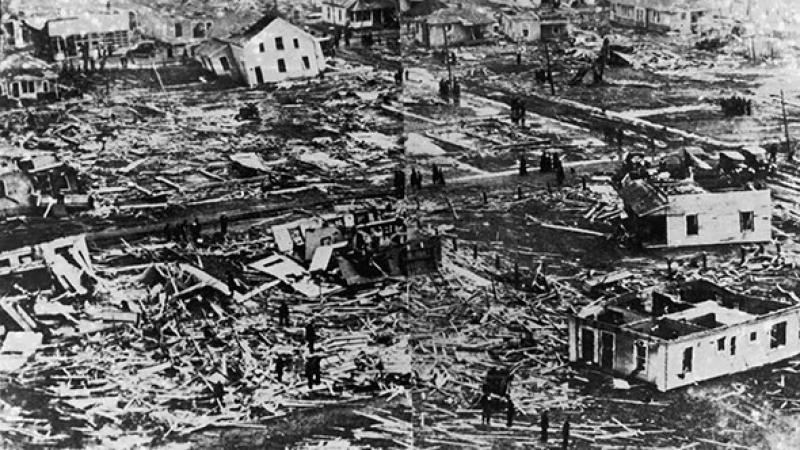The Deadliest Tornado in U.S. History


Overturned trains. Timber found miles away from where it had been stored. Trees felled. Fires and close calls. A letter that flew almost 100 miles. On a normal day in the Midwest in 1925, any one of these stories would have been worthy of front-page coverage. But March 18, 1925 was a day like no other the region had ever seen.
That day, a huge outbreak of tornadoes marched across a swath of the Midwest and Southeast. The largest of them all—the deadliest tornado in United States history—laid waste to parts of Missouri, Illinois and Indiana. Now known as the Tri-State Tornado, it turned March 18 into a day of gruesome destruction and bizarre survival stories.




Historic destruction in the mid west.
300 MPH winds, that's almost impossible to compute.
I had no idea that this existed.
Holy Moly this went on till 1950? That's nuts.
tornado (n.)
1550s, ternado , navigator's word for violent windy thunderstorm in the tropical Atlantic, probably a mangled borrowing from Spanish tronada "thunderstorm," from tronar "to thunder," from Latin tonare "to thunder" (see thunder (n.)). Also in 17c. spelled tornatho , tornathe , turnado ; modern spelling by 1620s. Metathesis of -o- and -r- in modern spelling influenced by Spanish tornar "to twist, turn," from Latin tornare "to turn." Meaning "extremely violent whirlwind" is first found 1620s; specifically "destructive rotary funnel cloud" (especially in the U.S. Midwest) from 1849. Related: Tornadic .
Wow 300 MPH ..... that is hard to imagine.
A Terrifying, Deadly Storm Struck Mississippi In 1936… And No One Saw It Coming
On April 5, 1936, one of the deadliest spates of tornadoes in United States history struck several southern states, with Mississippi receiving some of the worst damage. The first of the deadly twisters touched down in Coffeeville then headed to Tupelo, devastating the town. By the time the unexpected twister arrived in Tupelo, it was an F5 that was three blocks wide, with wind speeds in excess of 300 miles per hour. According to some reports, the wind was so strong that it caused pine needles to become embedded in the trunks of trees.
When all was said and done, the tornado claimed the lives of 216 Tupelo residents; however, the number is actually much higher as the names of African-Americans were not reported. One notable survivor of the 1936 twister is Elvis Presley, who was just one-year-old at the time. Regardless of how much time has passed, this Tupelo twister remains one of the worst in the nation’s history.
The death toll, potentially including the Black death count, is said to exceed 400+. Mom's family lived 2 miles from the Crossroads in East Tupelo when the storm came through. They said it touched down about 1/2 mile from their house - three houses down from young Elvis - with half the roof being picked off and then the entire neighborhood heading East was just flattened. Mom was 13 at the time.
Each time Dad got his orders to any Southern Post in Texas, Georgia, Alabama or Louisiana, Mom would start getting nervous. Now I know why.
Eleven years after the 1925 and the weather bureau didn't issue warnings....Can't wrap my head around that.
When nature isn't being beautiful it can get really ugly.
E.
Just when humans think that we are in control, mother nature gives us a awakening..Many times in the form of destruction that is near impossible to understand.